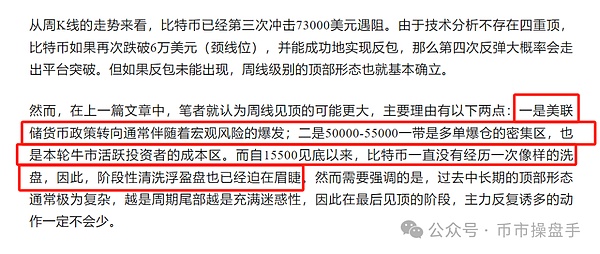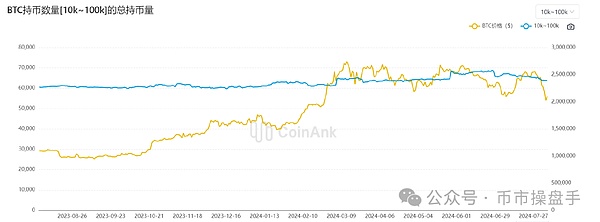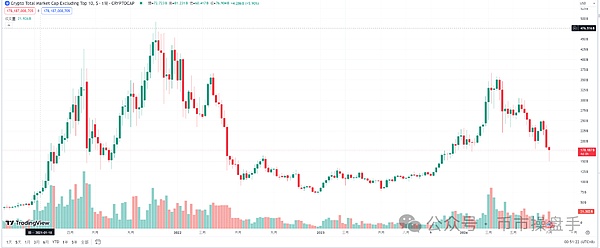Source: Coin Market Trader
Recently, the crypto market has ushered in the most violent adjustment of this round of bull market. According to Coinglass data, the price of Bitcoin has fallen sharply from US$70,079 to US$49,000 in the past week, a drop of 30%, the largest single-week drop since 2023. In particular, on August 5, the amount of forced liquidation of leveraged longs on the chain reached US$1.2 billion. Such a liquidation scale has only appeared in the "519 market" in history, which shows how tragic the adjustment is. However, a week before the market plummeted, we repeatedly reminded of the risk of the weekly peak and gave an adjustment target of 50,000-55,000. If you follow this idea, even if you don't make a profit, you can basically avoid most of the risks.
There are many different opinions on the reasons for the market crash. The author believes that the main reasons can be attributed to two points: First, the unemployment rate has exceeded expectations for three consecutive months, which has further exacerbated market concerns about the US economic recession. In addition, the sudden interest rate hike by the Bank of Japan triggered the carry trade liquidation procedure, resulting in a large-scale sell-off of US dollar assets. Secondly, before launching a new round of rising prices, Bitcoin usually needs to conduct a strong cleanup of the floating profit plate. The 50,000-55,000 is not only a dense area of long orders, but also a cost area for active investors in this round of bull market. It is naturally an indispensable link to clean up this position. Although the emergence of macro risks is accidental, historically, whenever the Federal Reserve's monetary policy shifts, the probability of macro risks breaking out is almost 100%.

Before Bitcoin fell sharply, the on-chain indicators had actually sent out a signal to escape the top: in the process of Bitcoin rebounding from US$54,000 to US$70,000, Bitcoin whales holding between 10K and 100K continuously reduced their holdings of 121,604 bitcoins. This reduction cycle lasted for a rare 30 days. This phenomenon shows that smart money has avoided the risk of falling in advance, and the rebound in late July is actually the last lure before the decline. Although Bitcoin rebounded strongly after hitting the bottom on August 5, the on-chain whales have not resumed the action of increasing their holdings so far, which shows that the market may still face the risk of a second bottom after the big drop.

So, what other negative factors may trigger a second decline in the market? According to JPMorgan Chase's forecast, the Bank of Japan's interest rate hike will trigger the liquidation of $1 trillion in yen carry trades, and the current liquidation scale is only half completed. In addition, a Bloomberg survey last Tuesday showed that about 65% of the 34 Japanese economists surveyed expected Japan to continue to raise interest rates this year, which means that the size of carry trade liquidation may increase further. However, from the current point of view, the possibility of a hard landing of the US economy is not great, mainly for the following two reasons: First, although the unemployment rate in July exceeded expectations, the pricing of the US SOFA interest rate shows that the market's expectations for US interest rates next year are only 25 basis points lower than originally expected, which is inconsistent with the continuous and substantial interest rate cuts predicted by the outside world. Second, the increase in the unemployment rate in July was mainly affected by one-off factors, such as the tornado disaster in Texas, which caused 249,000 people to be temporarily unemployed. In short, as long as the US economy does not experience a hard landing, the capital market is expected to gradually get out of the downturn during the interest rate cut cycle.
In this round of adjustments, altcoins continue to be the hardest hit by valuation cuts. According to AIcoin data, as of August 5, the total market value of altcoins (excluding the top 10) fell to $149 billion, down nearly 60% from this year's peak of $366 billion. If the 31 newly issued altcoins since January 2013 are excluded, their market value is only $84 billion, an increase of 12% in this round of bull market. It is worth noting that in 2021, the circulating market value of the two projects, DOT and ICP, alone reached $80 billion, which reflects the current downturn in the altcoin sector.

However, with the changes in the market environment, the reorganization of the chip structure, and the gradual improvement of the valuation cost performance, the altcoin is gradually approaching a reversal of difficulties. First, as the United States gradually enters a cycle of interest rate cuts, the market risk appetite is expected to rebound. At this stage, small-cap projects (companies) with good growth usually perform better. Secondly, after the altcoin and Bitcoin completed the co-shock decline, the altcoin began to reverse the past decline, and the market value share and daily transaction share both rebounded significantly, indicating that some funds have begun to adjust their positions. Finally, every round of large-scale capital circulation in history will produce a sedimentation effect. For example, although the Internet technology bubble in 2000 led to a three-year bear market in the industry, 12% of the companies eventually became industry giants and entered a long-term bull market. The current altcoins are also similar to the precipitation stage after large-scale capital investment, waiting for the emergence of new catalysts. Of course, I do not think that the past altcoin bull market will reappear. The reversal of the plight of altcoins is more likely to occur in the leading projects in various segments, and its manifestation will still be a structural bull market. The difference is that compared with the past, there are more market opportunities and the money-making effect is more obvious.
In terms of operation, considering that the macro risks have not been completely cleared, Bitcoin will continue to fluctuate and bottom out in the short term, and it is not ruled out that it will continue to test the 55,000 area this week. On the market, the surge in XRP has led to the counterattack of altcoins. Many altcoins have rebounded from the bottom by more than 30%. It is expected that the fermentation of the altcoin market will continue.
 JinseFinance
JinseFinance








